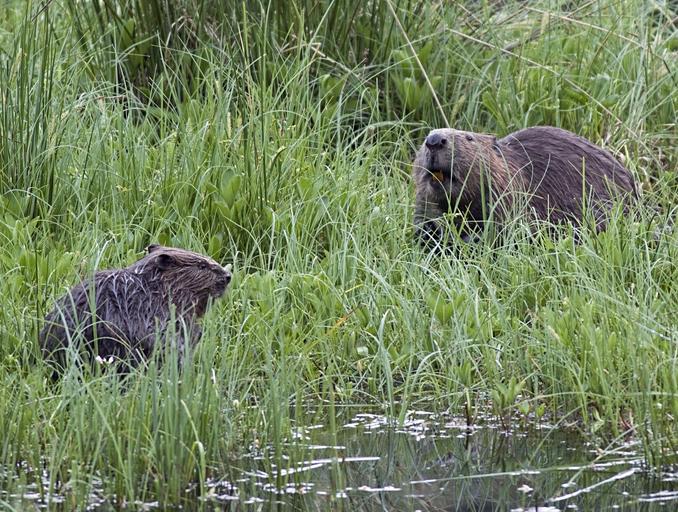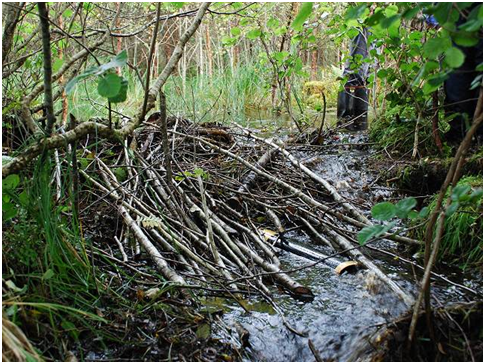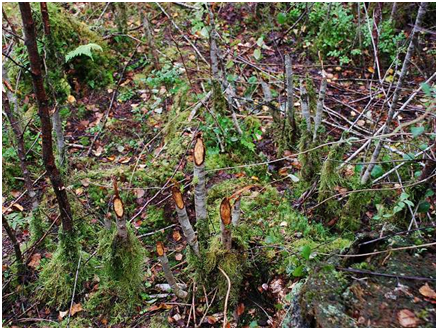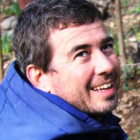
Figure 1: Tayside beaver mother and kit
Figure 1: Tayside beaver mother and kit
Photograph by Ray Scott. Click here to view Wikimedia source.
 This work is licensed under a Creative Commons Attribution-ShareAlike 3.0 Unported License.
This work is licensed under a Creative Commons Attribution-ShareAlike 3.0 Unported License.
All over the world, species are dying at an unprecedented rate. As such, it has become generally agreed within the realm of natural sciences that we are already living through or, at the very least, hurtling towards the sixth mass extinction: an era characterized by the extensive loss of life on Earth. Consequently, it is also a time in which stories of sorrow and grief have come to dominate the narratives surrounding humans’ relationships with nonhuman others. A direct response to the loss of species in this time of increasing extinction is the practice of rewilding. Rewilding seeks to restore species in their original locations, in the hope of reinvigorating both the species and the habitats in which they live. However, contemporary rewilding projects are not seeking to return environments to their historic states. Rather, as Monbiot (2013) explains, through the reintroduction of species to an area, rewilding seeks to allow the natural environmental processes of that area to resume, unhindered and uncontrolled by humans. One such example of rewilding is that of the “Scottish Beaver Trial” project, a five-year venture that sought to successfully reintroduce beavers into Knapdale Forest, Mid-Argyll. The project started in 2009 and was led by the Scottish Wildlife Trust, in partnership with the Royal Zoological Society of Scotland and the Forestry Commission Scotland.

Figure 2: Beaver dam
Figure 2: Beaver dam
Photograph by Patrick Mackie. Click here to view Wikimedia source.
 This work is licensed under a Creative Commons Attribution-ShareAlike 2.0 Generic License.
This work is licensed under a Creative Commons Attribution-ShareAlike 2.0 Generic License.
Although there has been discussion about reintroducing beavers since the 1990s, and even one failed application for a trial made in 2002, the Scottish Beaver Trial first became reality in May 2008, when the Scottish Government finally approved an application for a trial reintroduction. This was the first legally supported case of mammal reintroduction in the UK, and its success was paramount in gaining support for future rewilding projects. Exploring the history of beavers in Scotland, Conroy and Kitchener (1997) write that beavers were first thought to have become extinct in this location during the fifteenth and sixteenth centuries and, somewhat typically, it is thought to have been the result of exploitative human behaviours, such as over-hunting and habitat destruction. The reintroduction trial began on 28 and 29 May 2009, when 11 Eurasian beavers, originally captured in Norway, were released into three separate freshwater lochs in Knapdale Forest. Jones and Campbell-Palmer (2014) revealed in the Scottish Beaver Trial’s final report that, in the following days, it was estimated that over ten million people either read, heard, or listened to news of the beavers’ release. This creature’s charismatic qualities, coupled with the experimental and somewhat controversial nature of the trial, meant that the project attracted unprecedented interest.
The trial lasted five years and, despite expected hiccups and a challenging start, was an overall success. In 2010 the first beaver kit was born, and today the Scottish beaver populations remain relatively stable. In 2016, two years after the conclusion of the trial, the beavers were granted “native species” status by the Scottish government, ensuring their continued protection.

Figure 3: Birch felling by beavers
Figure 3: Birch felling by beavers
Photograph by Patrick Mackie. Click here to view Wikimedia source.
 This work is licensed under a Creative Commons Attribution-ShareAlike 2.0 Generic License.
This work is licensed under a Creative Commons Attribution-ShareAlike 2.0 Generic License.
The beavers’ new status was partly awarded due to their reputation as ecosystem engineers: they tend to modify their environments by creating dams, canals, wetlands, and lodges that attract the attention of species that might not normally reside in those environments. As such, during the trial the beavers significantly increased biodiversity by transforming the landscape of Knapdale Forest and increasing habitat heterogeneity, as is shown in figures 2 and 3. Although the modifications that the beavers made to their new habitats stirred some controversy, particularly amongst local farming populations, the impact of the beavers’ alterations to their environments was predominantly positive. Another aspect that fed into the success of this project was the extent to which those working on the project used the trial to engage with external individuals and communities, through benefiting local economies, offering new educational experiences, and generally making their research accessible to others. The development of an active, professional website that offered both scientific and video updates, educational resources, and visitor information demonstrates the thoroughly inclusive nature of the trial. Following the overall success of the Scottish Beaver Trial, beavers have now also been reintroduced in areas such as Devon and Cornwall.
In a time in which both popular and academic texts are filled with stories of loss and destruction, it is vital that narratives such as this, of positive environmental action and outcomes, continue to be produced. My intention in telling this story of a successful rewilding project is not to bypass the controversial nature of many rewilding projects or to produce a rosy picture of how humans might respond to or resist the extinction of species. Rather, it is intended as a positive reminder that there are ways in which the efforts of a few individuals can work to save or revive many of the species and habitats that have become fundamental to the existence of humans and, indeed, all species. Rewilding projects, if approached with considerable caution and implemented properly, can provide an avenue of hope and offer a way of resisting the ever-increasing losses that are occurring in the modern world.
How to cite
Portus, Rosamund. “Resistance and Rewilding: The Return of Beavers to Knapdale Forest.” Environment & Society Portal, Arcadia (Spring 2018), no. 9. Rachel Carson Center for Environment and Society. doi.org/10.5282/rcc/8317.
ISSN 2199-3408
Environment & Society Portal, Arcadia
 This work is licensed under a Creative Commons Attribution 4.0 International License.
This work is licensed under a Creative Commons Attribution 4.0 International License.
2018 Rosamund Portus
This refers only to the text and does not include any image rights.
Please click on an image to view its individual rights status.
- Conroy, J. W. H., and Andrew C. Kitchener. “The History of the Eurasian Beaver Castor fiber in Scotland.” Mammal Review 27, no. 2 (1997): 95–108.
- Jones, Simon, and Róisín Campbell-Palmer. The Scottish Beaver Trial: The Story of Britain’s First Licensed Release into the Wild. Scotland: Scottish Wildlife Trust and Royal Zoological Society of Scotland, 2014.
- Leakey, Richard, and Roger Lewin. The Sixth Extinction: Patterns of Life and the Future of Humankind. New York: Anchor Books, 1996.
- Monbiot, George. Feral: Rewilding the Land, Sea and Human Life. London: Allen Lane, 2013.
- Scottish Natural Heritage. Re-introduction of the European Beaver to Scotland: A Public Consultation. Battleby: Scottish Natural Heritage, 1998.
- Van Dooren, Thom. Flight Ways: Life and Loss at the Edge of Extinction. New York and Chichester, West Sussex: Columbia University Press, 2014.
- Wright, Justin P., Clive G. Jones, and Alexander S. Flecker. “An Ecosystem Engineer, the Beaver, Increases Species Richness at the Landscape Scale.” Oecologia 132, no. 1 (2002): 96–101.








